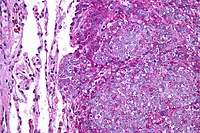
Photo from wikipedia
The fifth edition of the World Health Organization classification of soft tissue and bone tumors redefined Ewing sarcoma by fusions between EWSR1/FUS and ETS family of transcription factors, and recognized… Click to show full abstract
The fifth edition of the World Health Organization classification of soft tissue and bone tumors redefined Ewing sarcoma by fusions between EWSR1/FUS and ETS family of transcription factors, and recognized three tumor groups among Ewing‐like sarcoma: CIC‐rearranged sarcoma, sarcoma with BCOR genetic alterations, and round cell sarcoma with EWSR1::non‐ETS fusions. Although this classification underscores the critical role of molecular genetics in the diagnosis of small round cell sarcoma, each entry is recognized as a specific entity not only because they have different genetics but because their phenotypes are distinct and reasonably robust to support the diagnosis. This review focuses on the morphological aspects of Ewing sarcoma and a subset of Ewing‐like sarcomas (CIC‐rearranged sarcoma, BCOR‐associated sarcoma, and EWSR1::NFATC2 sarcoma) for which phenotypic characteristics have been well established. Classic histological findings, uncommon variations, and recurrent diagnostic pitfalls are addressed, along with the utility of recently developed immunohistochemical markers (NKX2.2, PAX7, ETV4, BCOR, CCNB3, and NKX3.1). Phenotypic expertise would significantly expedite the diagnostic process and complement (or sometimes outperform) genetic testing, even in well‐resourced settings. Morphological knowledge plays an even more substantial role in facilities that do not have easy access to molecular testing.
Journal Title: Pathology International
Year Published: 2022
Link to full text (if available)
Share on Social Media: Sign Up to like & get
recommendations!